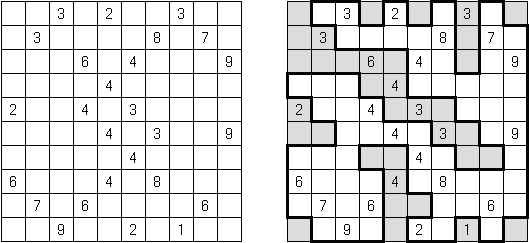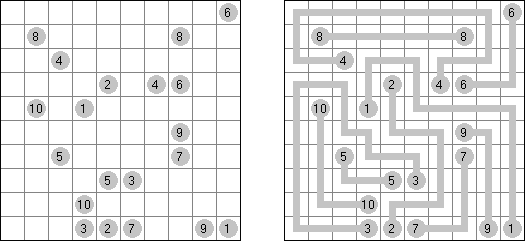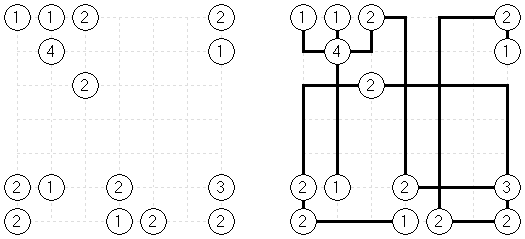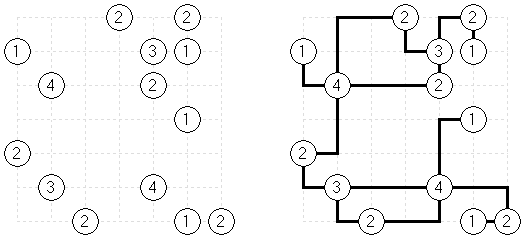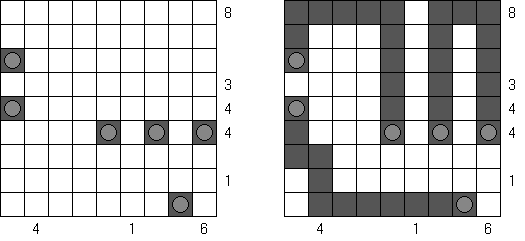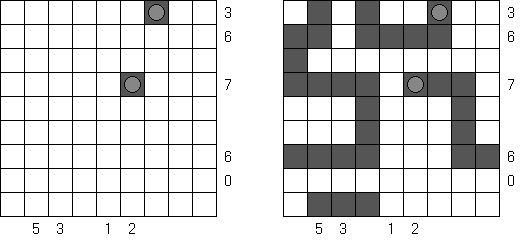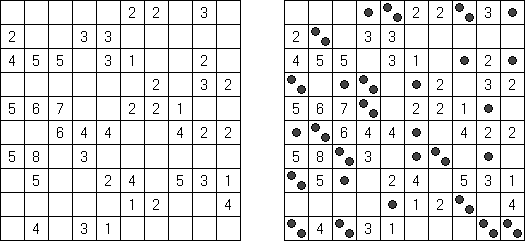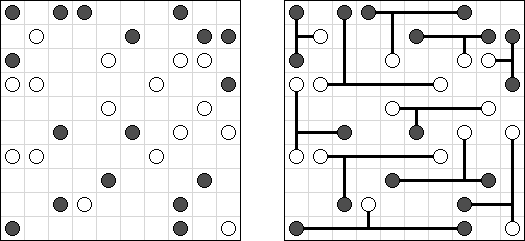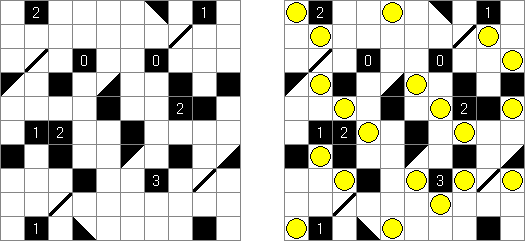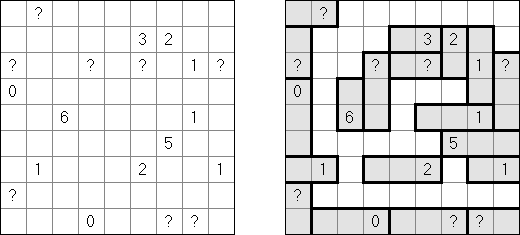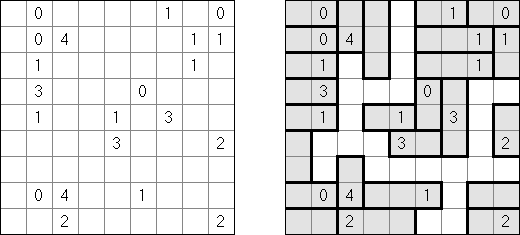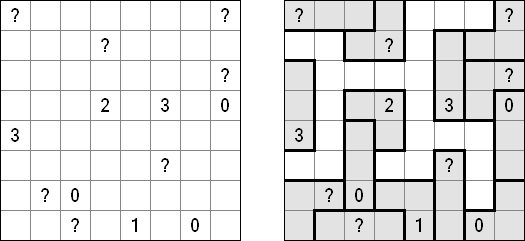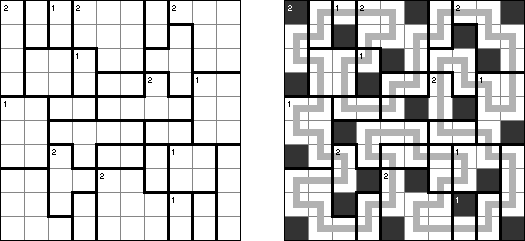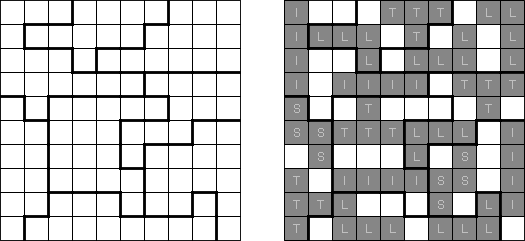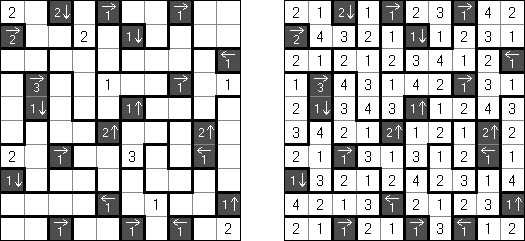|
Varianti di rompicapi
|
Cross+A  Varianti di rompicapi Varianti di rompicapiAlcuni puzzle presentano variazioni rispetto alle regole classiche. Cross+A è in grado di risolvere e creare queste variazioni di puzzle (sia nella stessa finestra della versione classica, sia in una finestra separata come nuovo tipo di puzzle).
Slitherlink Pecore e lupi ("Sheep and Wolves"): oltre ai numeri da 0 a 3, sono presenti anche cerchi neri ("pecore") e crocette nere ("lupi"). Una volto risolto il rompicapo, le "pecore" devono restare all’interno della linea chiusa ("all’interno dello steccato"), mentre i"lupi" all’esterno della linea chiusa ("all’esterno dello steccato").
Battaglia navale Digital Battleships contiene i numeri in tutte le caselle della griglia. I valori numerici al fuori della griglia indicano le somme dei numeri solo in quelle caselle che contengono i frammenti delle navi, nelle rispettive righe e colonne. Le navi, "nascoste" in mezzo ai numeri, non possono toccarsi una con l’altra nemmeno con gli angoli.
Retrograde Battleships ("Reverse Battleships") contains all segments of the ships in the grid. The aim is to find the correct locations of the ships. No ship may touch another, even diagonally.
Fillomino No Rectangles Fillomino: contiene una regola supplementare: nessuno dei blocchi deve presentare una forma rettangolare o quadrata.
Only Rectangles Fillomino: tutti i blocchi devono presentare una forma rettangolare o quadrata.
No 2 x 2 Squares Fillomino: nella casella non ci deve essere alcuna zona dalle dimensioni di 2 x 2 contenente numeri uguali.
Non-Consecutive Fillomino: le caselle dei due blocchi che si intersecano in orizzontale o verticale non devono differenziarsi per unità.
Consecutive Fillomino: ogni blocco deve intersecarsi in orizzontale o verticale almeno con un blocco la cui dimensione si differenzi per unità.
No Row/Column Repeats Fillomino ("Deadomino"): tutti i numeri uguali nella fila o nella colonna devono appartenere allo stesso blocco. Ad esempio, se in una fila sono presenti due numeri "5", entrambi appartengono allo stesso blocco.
All Odds Fillomino: le dimensioni di tutti i blocchi sono dei numeri dispari.
All Evens Fillomino: le dimensioni di tutti i blocchi sono dei numeri pari.
Nurikabe Pairs Nurikabe si differenzia dalla comune variante del rompicapo Nurikabe per il fatto che ogni "isola" contiene due numeri la somma dei quali è uguale alle superficie dell’isola.
Line Nurikabe: a grid cannot contain five consecutive black cells in a row or column (2 x 2 cell area can be all black).
Grattacieli Sum Grattacieli ("Sum Skyscrapers") si differenzia dai rompicapo Grattacieli ("Skyscrapers") col fatto che le cifre al di là del campo significano non il quantitativo di case visibili, bensì la somma di tutti i piani di queste case.
Tapa Esistono moltissime varianti del rompicapo Tapa. Il programma Cross+A è in grado di risolverne alcune. In Tapa [Line] viene impiegata una regola supplementare: non ci devono essere linee di quattro caselle consecutive sia in orizzontale che in verticale.
No Squares Tapa: non ci deve essere nessun quadrato 2 x 2 composto solamente da caselle bianche.
Equal Tapa: il quantitativo di caselle bianche (ad eccezione delle caselle che contengono i numeri) deve essere pari al quantitativo delle caselle nere.
B&W Tapa:
Tapa Islands:
Pata:
Tapa Balance: il quantitativo di caselle nere nella parte sinistra coincide con il quantitativo di caselle nere nella parte destra. Le caselle bianche e le caselle con i numeri non vengono considerate.
Tapa Row: la somma di tutti i numeri in fila è uguale al quantitativo di caselle nere in questa fila.
Tapa 1-n: tutte le file e le colonne devono contenere diversi quantitativi di caselle nere.
Dissected Tapa: le caselle nere e le caselle bianche formano due figure congruenti. Due figure vengono chiamate congruenti se coincidono fra loro quando vengono sovrapposte.
Tapa [Diagonal Neighbors]: ogni casella nera deve averne almeno una adiacente nera in diagonale.
Corral Inside/Outside Corral - variante del rompicapo Corral. Si contraddistingue per il fatto che i numeri possono trovarsi sia all’interno della linea chiusa che al suo esterno. In entrambi i casi, il numero significa il quantitativo di caselle "visibili", compresa la casella stessa con il numero.
Arukone Arukone3:
Easy as ABC Not as Easy as ABC is a variation of Easy as ABC puzzle. The goal is to fill in the first letters of the alphabet on every row and every column exactly once. One cell in every row and every column remains empty. Letters and numbers on the outside indicate at what position you come across this letter when looking from that side (e.g. C2 means the C is the second letter encountered when looking from that side).
Ichimaga Crossing Ichimaga: the lines may cross other lines; the lines cannot change direction at the point of intersection.
Magnetic Ichimaga ("Jishaku-Ichimaga"): the circles with the same digits cannot be connected.
Snake Multiple Snakes: a grid contains multiple snakes. Head and tail of all snakes are given. Different snakes do not touch each other, even diagonally.
Toroidal Snake: a grid wraps around itself. A snake can go from one edge to another.
Campo minato Doppio campo minato ("Double Minesweeper"): place mines into each empty cell in the grid, at most two mines per cell.
Mirukuti Milk Tease is a variation of Mirukuti ("Milk-T") puzzle. T-shaped line may connect:
Two circles of the same color must be connected by the straight-line segment of the T-shaped line.
Akari Mirror Akari ("!irakAkari!"): a square or rectangular grid contains diagonal walls (black triangles) with mirrors.
Tren Tren+:
Ghost Tren:
Mubunanba Mubunanba+:
Yajilin Regional Yajilin (also known as "Yajilin (Regions)") is a square or rectangular grid divided into regions. The aim is to blacken some cells and to draw a single non-intersecting loop through all the white cells. A number in a region indicates the number of black cells in that region. A region without a number can contain any amount of black cells. No two black cells can share a border. The loop may visit numbered cells; numbered cells can be blackened.
LITS Double LITS has one difference from the classic variant of the puzzle: each region must contain two tetrominoes. These two tetrominoes within a region cannot touch each other horizontally or vertically (only diagonally); they can be the same or different shapes.
Kapama Sunglasses is a logic puzzle. A rectangular or square grid contains lines ("bridges") in some cells. The goal is to blacken some cells to create pairs of figures (twin shapes). Twin shapes ("lenses") are symmetrical with respect to a bridge. Two lenses may not share an edge. Cells with bridges can not be blacken. Numbers outside the grid show the number of black cells in a corresponding row or column.
Makaro Masakuchi is a logic puzzle published by Nikoli. A rectangular or square grid is divided into regions. Each region must be filled with each of the digits from 1 to the number of cells in the region. When two numbers are orthogonally adjacent across a region boundary, the numbers must be different. The grid may contain black cells with arrows and numbers: the arrow points at the greatest number among the four cells around (up, under, left, right) the black cell. The number in the black cell shows the difference between the greatest number and the second highest number in all orthogonally adjacent cells around the black cell.
|
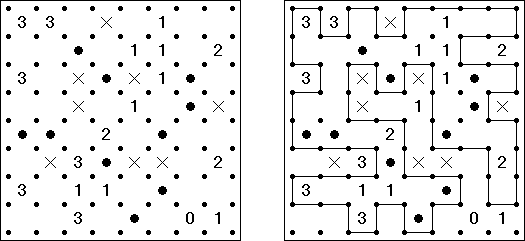
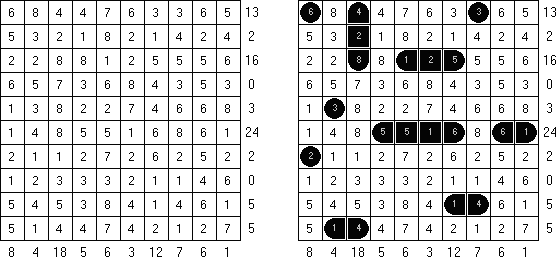

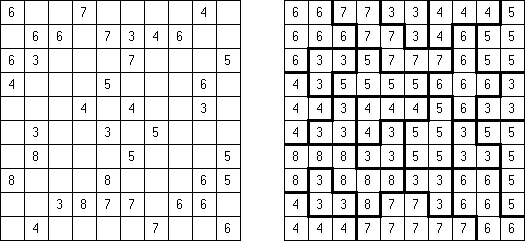

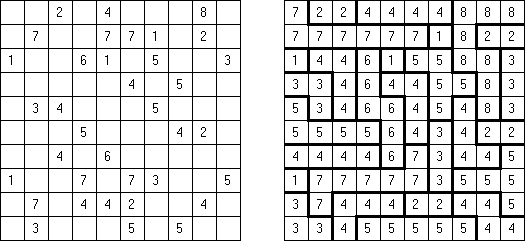
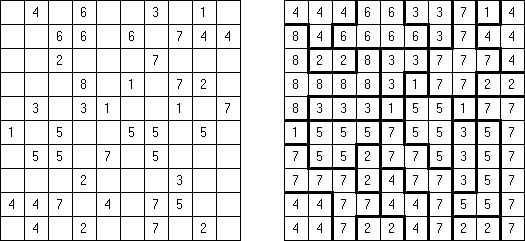
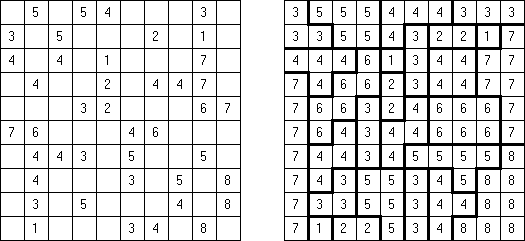
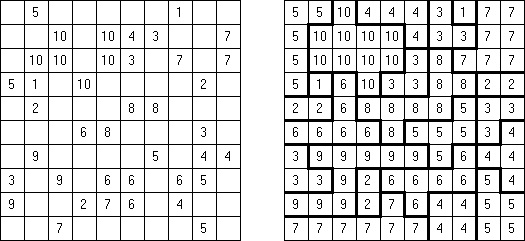


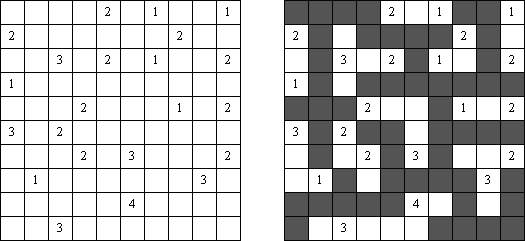

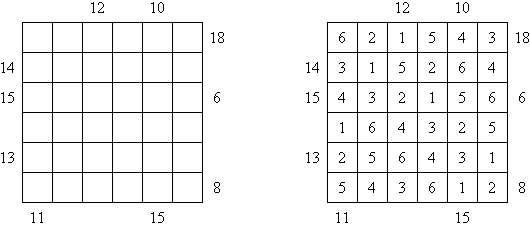
![Tapa [Line]](../data/tapa1.gif)
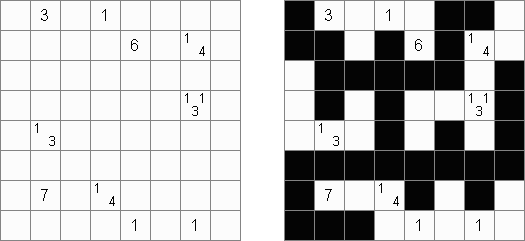
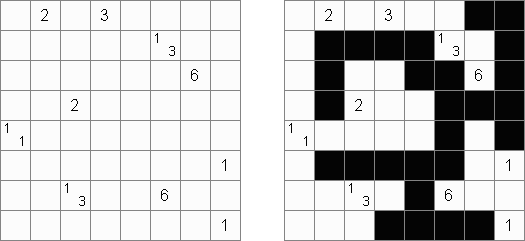


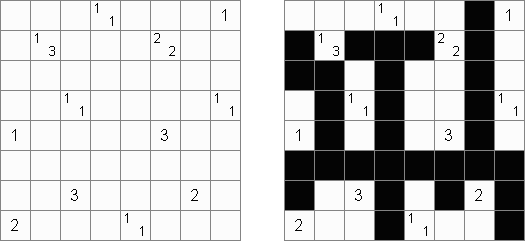
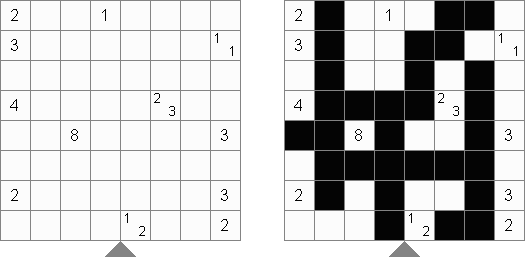
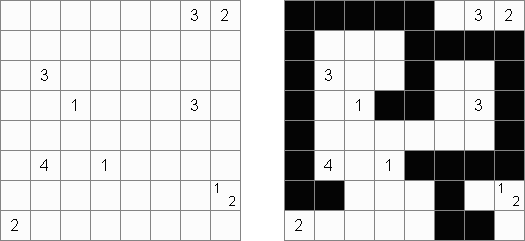

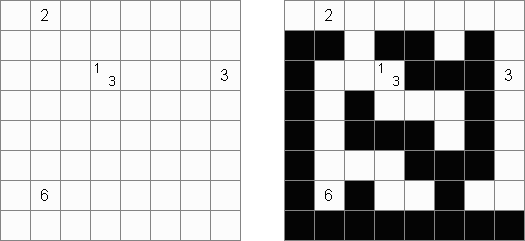
![Tapa [Diagonal Neighbors]](../data/tapa11.gif)
